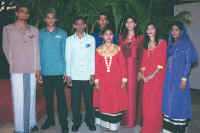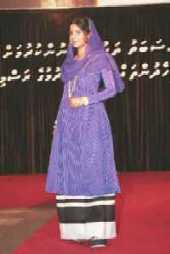|

Some of the dresses exhibited at a fashion show
to identify a national dress (photo: Haveeru)
Sometimes a subjugated country develops a national dress as a symbol of resistance against foreign domination. This was how the Scots popularized their national dress during the 17th and 18th centuries when the English were dominating them. Till then the tartan kilt was worn only by a few highlanders. It was more or less the same story with the
inars, trews and brahts of Ireland.
Perhaps because of this bitter history, the traditional dress is a sacred cow for Gaelic people, as Prince Charles once discovered to his dismay. For a costume ball at Buckingham Palace some years ago he wore a kilt as his “costume”. Anyone who has seen a kilt can understand how he could have genuinely mistaken it for a fancy dress. But the Scottish guests at the ball were not amused at this perceived slight to their national dress and the embarrassed Prince had to beat a hasty retreat.

A young lady parading Dhivehi libaas : As
far as fashions go this dress is creative enough to challenge
the talents of an Armani or a Dior. (photo:
Haveeru)
Perhaps no country enforces dress codes as seriously as Bhutan. Under a 1988 policy, which the government says is aimed to “promote national integration and the Bhutanese identity”, it is compulsory for all citizens to wear
gho and kira at all times.
The government explains that the policy was implemented only after consulting the people.
Many other countries are not so serious about dress codes. Even though Japan has a national dress, the
kimono, for both sexes, one rarely sees the dapper Japanese in anything except a designer suit. Singapore, the other developed country in Asia, ostensibly does not saddle itself with a national dress. But all high-flying business visitors to the island are well advised to pack their tuxedoes unless they enjoy feeling like hermit crabs without shells.

While a libaas makes an impressive fashion
statement, it is not practical as everyday wear. The price tag
is also steep. (photo: Haveeru)
In the Maldives people have used traditional dresses like
feyli, libaas, faaskuri hedhun and mundu. Even today, official functions showcase some of these. We may choose to reinvent them as our national dress. But whatever we do, it doesn’t hurt to look smart. Oscar Wilde once said, “Clothes maketh a man.” To this we can add, “costumes maketh a clown.”
| 



